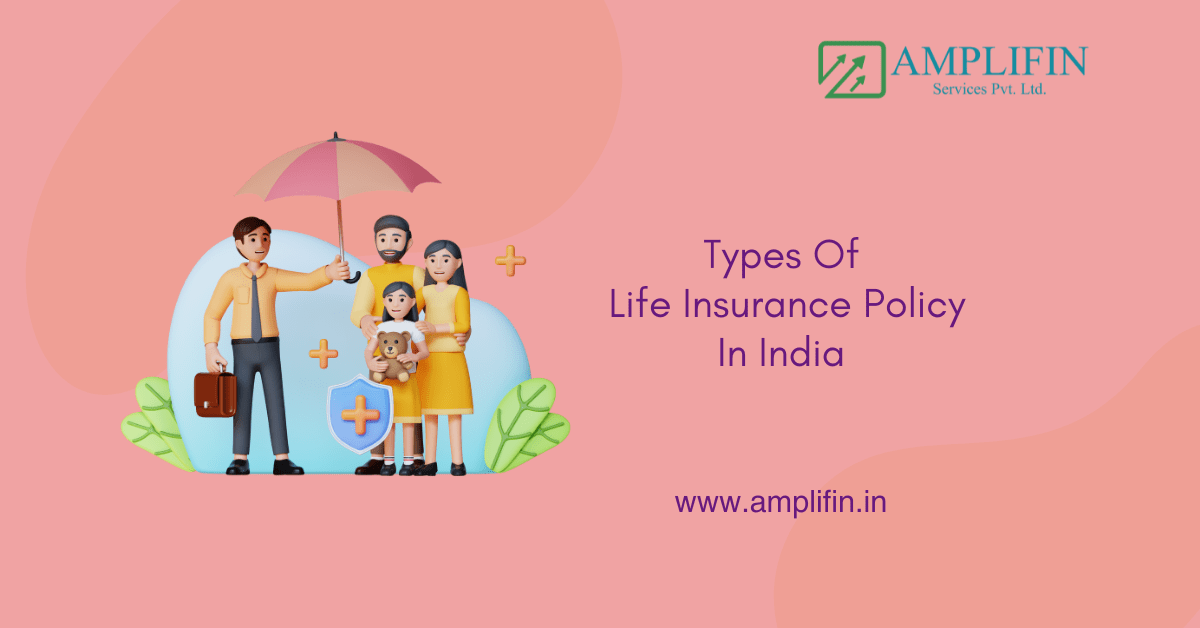The Ultimate Guide to Different Types of Life Insurance Policy In India: Choosing the Right Type Of Life Insurance Plan in India
Life insurance is a crucial financial tool that offers protection and peace of mind to individuals and families. Understanding the different types of life insurance available in India is essential for making informed decisions that suit your needs. In this article, we will explore various life insurance policies in India, their benefits, and how to choose the right one for you. Whether you’re looking for a term insurance plan or a whole life insurance policy, this guide will help you navigate your options effectively.

Why You Should Read This Article
This comprehensive guide will equip you with the knowledge needed to make educated choices regarding your life insurance policy. By understanding the types of life insurance, you’ll be able to secure your family’s financial future, enjoy peace of mind, and even plan for retirement. Let’s dive into the essential aspects of life insurance in India.
Outline
1. Understanding Different Types of Life Insurance
2. Key Components of a Life Insurance Policy
3. Whole Life Insurance: A Comprehensive Coverage Option
4. Term Insurance: A Simple and Affordable Solution
5. Endowment Plans: Combining Insurance with Savings
6. Unit Linked Insurance Plans (ULIPs): Flexible Investment Choices
7. Child Insurance Plans: Securing Your Child’s Future
8. Retirement Plans: Ensuring a Comfortable Retirement
9. Group Insurance: Benefits for Organizations and Employees
10. Choosing the Best Life Insurance Policy in India
11. Summary of Important Points to Remember
Understanding Different Types of Life Insurance Policy
When considering a life insurance policy, it’s vital to understand the various types of life insurance available through various insurance companies. Each type serves a unique purpose and caters to different financial needs. The most popular types of life insurance products include:
- Term Insurance: Provides coverage for a specific period, offering a death benefit if the policyholder passes away during the term.
- Whole Life Insurance: Offers lifelong coverage with a guaranteed payout to beneficiaries upon the policyholder’s death.
- Endowment Plans: Combine insurance and savings, providing a lump sum at maturity or a death benefit.
- Unit Linked Insurance Plans (ULIPs): Link insurance coverage with investment options, allowing policyholders to invest in various funds.
Key Components of a Life Insurance Plan
A life insurance policy typically includes several essential components:
- Premium: The amount paid regularly to keep the policy active.
- Sum Assured: The guaranteed amount payable to beneficiaries upon the policyholder’s death is known as the death benefit, an essential part of life coverage.
- Policy Term: The duration for which the insurance coverage is provided.
- Rider Benefits: Additional benefits that can be added to enhance coverage, such as critical illness riders.
Understanding these components is crucial for evaluating and comparing insurance plans available in India.
Whole Life Insurance Plan: A Comprehensive Coverage Option
Whole life insurance Term life insurance is a popular choice for individuals seeking lifelong protection. This type of life insurance policy provides coverage for the entire lifetime of the insured, as long as the premiums are paid. Key features include:
- Lifetime Coverage: Ensures that beneficiaries receive a payout no matter when the policyholder passes away.
- Cash Value Accumulation: Part of the premium contributes to a cash value that grows over time, which can be borrowed against or withdrawn.
- Stable Premiums: Premiums remain level throughout the policy’s life, providing financial predictability.
Whole life insurance is an ideal choice for those looking for long-term security.
Term Insurance: A Simple and Affordable Solution
Term insurance is a type of insurance that provides protection for a specified period. is a straightforward life insurance option that provides coverage for a specific period, typically ranging from 10 to 30 years. It is often considered one of the best types of life insurance due to its affordability. Key aspects include:
- Affordability: Generally, term insurance offers the most coverage for the lowest premium.
- Death Benefit Only: Provides a payout only if the insured passes away during the term, with no cash value component.
- Renewability Options: Many term plans offer the option to renew the policy after the term ends, usually at a higher premium.
For those looking for basic protection without the frills, a term insurance plan may be the right fit.
Endowment Plans: Combining Insurance with Savings
Endowment plans are unique as they blend insurance and savings. These policies pay out a lump sum either at maturity or upon the policyholder’s death. Key benefits include:
- Maturity Benefit: If the policyholder survives the policy term, they receive a lump sum, making it suitable for long-term financial goals.
- Death Benefit: Provides a payout to beneficiaries in case of the policyholder’s untimely demise.
- Financial Security: Acts as a dual-purpose plan, ensuring both insurance coverage and savings.
Endowment plans are a good choice for individuals looking to meet future financial goals while securing their family’s future.
Unit Linked Insurance Plans (ULIPs): Flexible Investment Choices
Unit Linked Insurance Plans (ULIPs) offer a combination of insurance and investment. This type of life insurance policy allows policyholders to invest in various funds while enjoying insurance coverage. Important features include understanding the policy tenure:
- Investment Flexibility: Policyholders can choose from different funds based on their risk appetite.
- Life Cover: Provides life insurance coverage in addition to investment benefits.
- Transparency: ULIPs provide regular updates on fund performance, helping policyholders track their investments.
ULIPs are ideal for those looking to combine insurance and investment in a single plan.
Child Insurance Plans: Securing Your Child’s Future
Child insurance plans are designed to ensure a secure future for your child. These policies provide financial protection and are often linked to educational or life milestones. Key advantages include:
- Future Security: Ensures financial support for children’s education and other important life events.
- Death Benefit: In case of the parent’s demise, the policy continues, ensuring the child receives the full benefits.
- Maturity Benefit: Often includes a lump sum payment when the child reaches adulthood.
For parents looking to invest in their child’s future, a child insurance plan is a valuable tool.
Retirement Plans: Ensuring a Comfortable Retirement
Retirement plans are essential for securing financial stability in your golden years. These plans help accumulate funds during your working years to provide a steady income post-retirement. Key components include:
- Regular Income: Provides financial support during retirement through periodic payouts; this is often a feature in a money back plan.
- Investment Options: Many retirement plans offer investment opportunities that can grow your savings.
- Tax Benefits: Contributions to retirement plans often qualify for tax deductions under Indian tax laws.
Investing in a solid retirement plan ensures you can enjoy your later years without financial stress.
Group Insurance: Benefits for Organizations and Employees
Group insurance is typically offered by employers to their employees as a part of the benefits package. This type of life insurance is beneficial for both parties involved. Important features include:
- Cost-Effectiveness: Group policies are often cheaper than individual plans due to the collective risk factor, and many insurance companies offer them.
- Automatic Coverage: Employees are automatically covered without the need for medical exams.
- Morale Booster: Offering insurance enhances employee satisfaction and loyalty.
Group life insurance is an attractive option for organizations looking to provide comprehensive benefits.
Choosing the Best Life Insurance Policy in India
Selecting the right type of life insurance can be overwhelming due to the myriad of options and types of insurance available. Here are some tips to help you choose the best life insurance policy:
- Assess Your Needs: Consider your financial goals, dependents, and risk appetite.
- Compare Policies: Evaluate different life insurance policies available in India based on premiums, coverage, and benefits.
- Understand Terms and Conditions: Read the policy document carefully to understand the coverage, exclusions, and claims process.
By taking these steps, you can find a policy that aligns with your financial objectives and provides the right life coverage.
Summary of Important Points to Remember
- Types of Life Insurance: Understand the differences between term insurance, whole life insurance, endowment plans, ULIPs, and child insurance.
- Key Features: Familiarize yourself with policy components like premiums, sum assured, and policy term.
- Financial Security: Life insurance is not just a safety net; it’s also a financial planning tool.
- Evaluate Needs: Always assess your individual needs and goals before purchasing a policy.
- Research Thoroughly: Take time to compare various policies and choose the one that best suits your requirements.
By remembering these key points, you can make informed decisions about your life insurance coverage.
This comprehensive guide has provided a detailed overview of the various types of life insurance available in India and how to choose the right policy for your needs. Whether you are looking for protection for your family or planning for your retirement, understanding your options is crucial to securing a bright financial future.
